| The Parish Church of St.
Lawrence |
| There has been a church on the
site since the 12th century. The first church is
believed to have been built by the first lord of the
manor, William de Darlaston. The church had a wooden
tower that had fallen into a bad state of repair by the
early 17th century. Dr. Pye, a native of Darlaston and
famous clergyman visited his relatives in the town
during 1606. Shaw describes it as follows in his
Staffordshire history:
In the year 1606, Dr. Pye coming to visit some
relations at this place, some of his servants went to
ring in the old steeple which was of wood, and much
decayed, so that their lives were in danger; upon which
he built a new tower of stone, upon condition the town
was at the expense of carrying it thither.
|
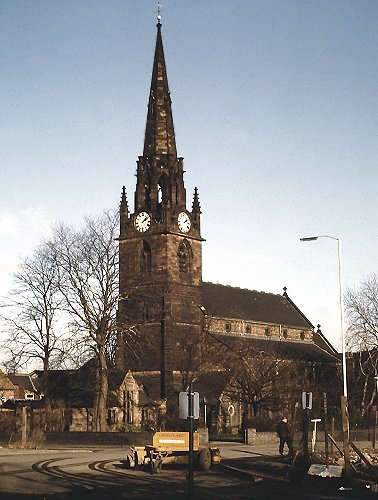
Taken by Richard Ashmore. Courtesy of John
and Christine Ashmore. |
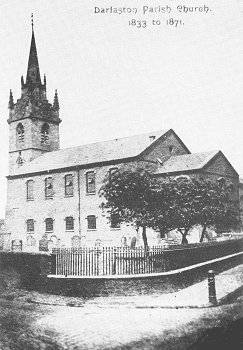
St. Lawrence's church as rebuilt
in brick in 1807. From an old postcard. |
Later in the 17th century the church was destroyed
by fire and rebuilt using salvaged material. The
building was enlarged by subscription in 1721 with the
addition of a new, brick-built, slightly enlarged
northern side. The church was again rebuilt in 1807 in
brick in a plain style, but only remained as such for a
few years.
In 1872 the brick building was replaced by a much
more ornate version in stone with a nave, chancel,
aisles and a porch. The final version of the main church
appeared in 1905-7 when the spire was rebuilt and a new
clock added at a cost of £3,000. In 1931 the church hall
was built at the western end of the church.
The church registers date back to 1539 and may be
viewed at the County Archives in Stafford. The Bishop's
Transcripts are to be found at Lichfield Record Office.
|
|

A winter view from around 1900. |
|
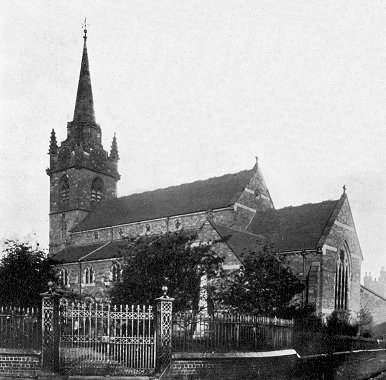
Another view of St. Lawrence's Church. |
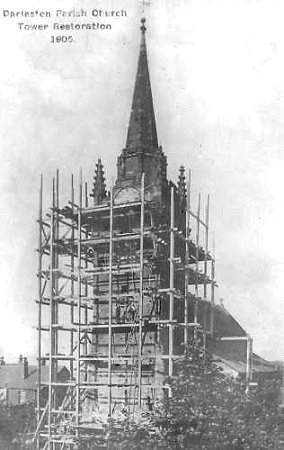
From an old postcard. |
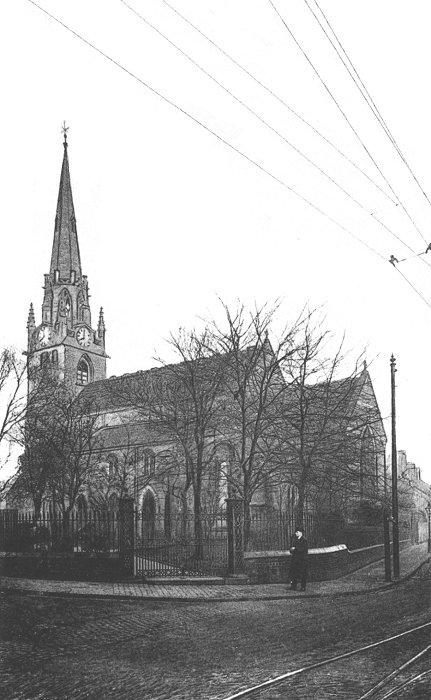
Another view of the Parish Church. From an old
postcard.
| A final view of the church.
Taken by Richard Ashmore in
the early 1970s. Courtesy of John
and Christine Ashmore. |
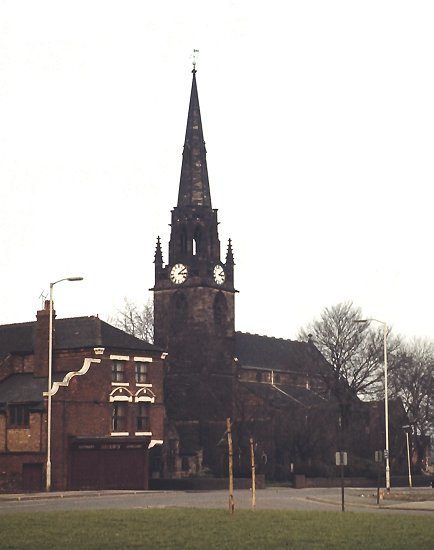 |
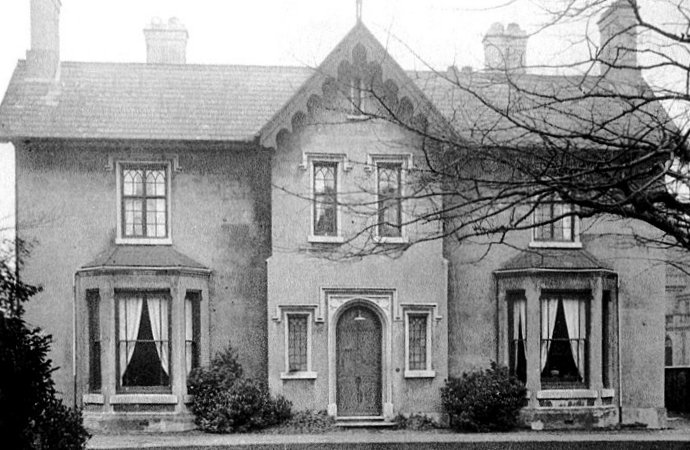 The old vicarage, off Victoria Road,
facing Church Street.
The old vicarage, off Victoria Road,
facing Church Street.
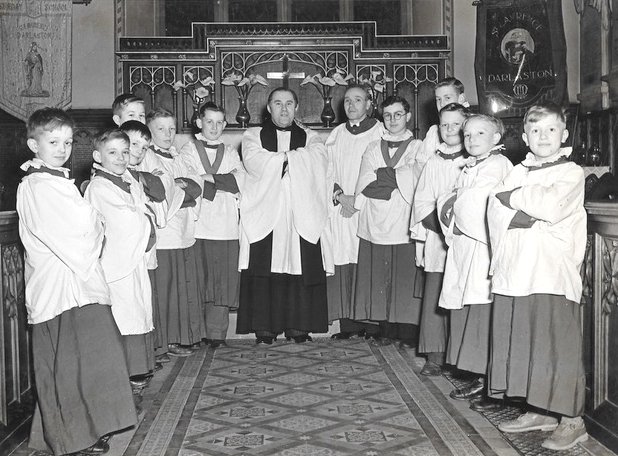
St. Lawrence's choir in about
1952, with the Rev. Brynmor Jones in the centre.
Next right is Mr. Foster the Choir Master, and 2nd
right is Brian Hingley. Standing next to the Rev.
Brynmor Jones, on the other side is Norman Newton,
who kindly sent the photo. He was Head Choir Boy.
|
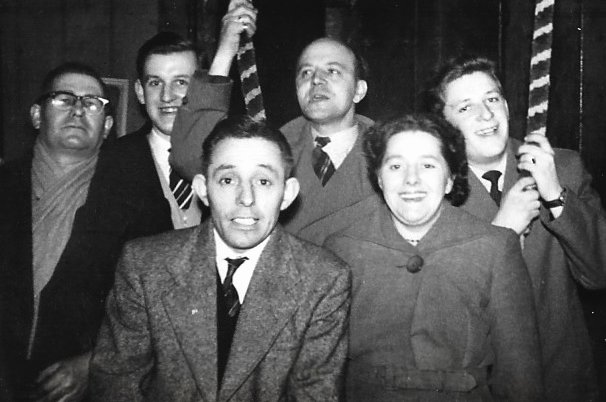
St. Lawrence's bell ringers in
about 1960. First left is David Hingley, the Ringing
Master, second left is Norman Newton who kindly sent the
photo. The two people in front are brother and sister,
Billy Parker, and Dolly Parker. After her marriage she
became Dolly Degville. I must thank Victoria Wilkes for
some of the names. |
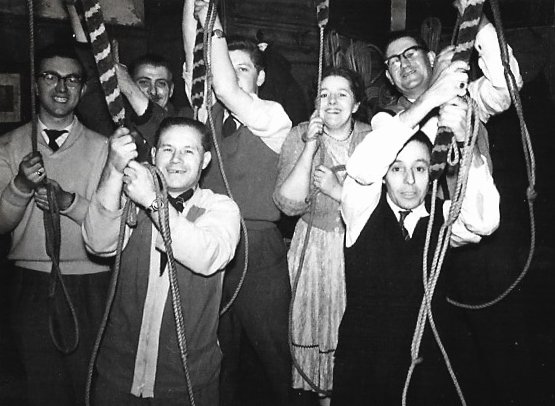
Another view of the bell ringers
with Brian Hingley on the left. Courtesy of Norman
Newton. |
Read about
St. George's Church |
 |
|
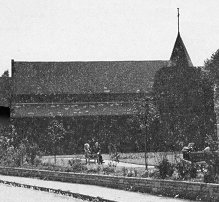
St. George's Church. |
| All Saints' Church
The parish of All Saints was formed in 1872, the church
being built and consecrated by Bishop Selwyn in the same
year. The building, in Early English style was built of
brick and designed by George Edward Street, R.A. The
church consisted of a nave, aisles, vestry and a small
turret with two exposed bells. The building seated 500
adults and 40 children and was erected as a memorial to
Samuel Mills by his widow and children. The church had
one of the finest stained-glass windows in
Staffordshire, made by Morris to the designs of the
artist Sir Edward Burne-Jones, R.A. and an organ built
by Bryceson Brothers and Morton.
|

The original Church.
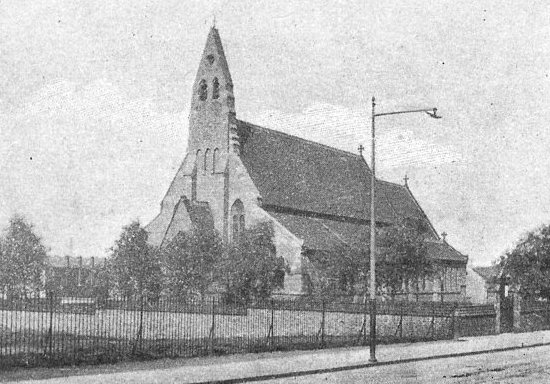
Another view of the church. From an old
postcard.
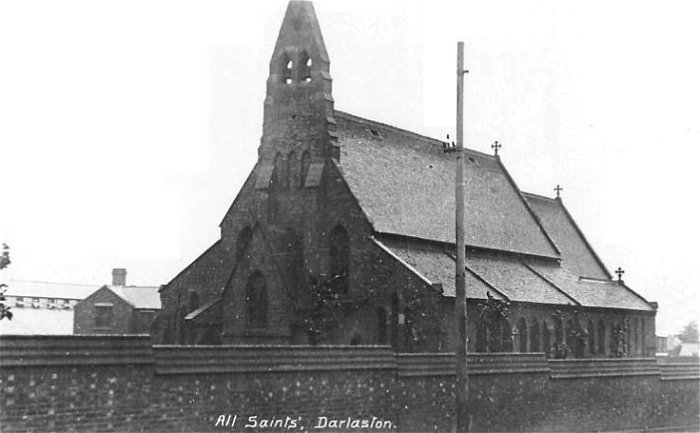
Another old postcard view.
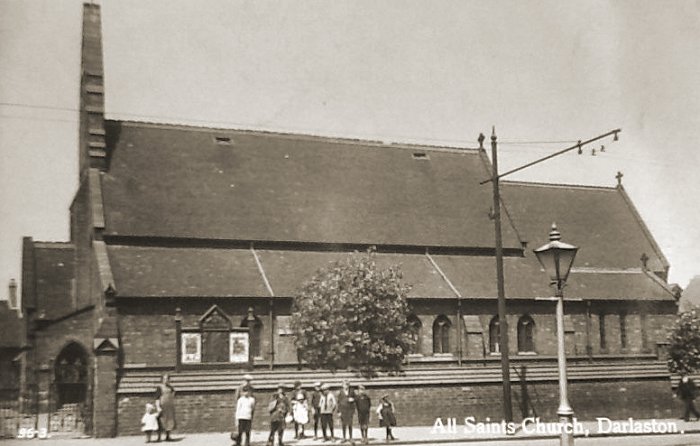
Another view, also from an old postcard.
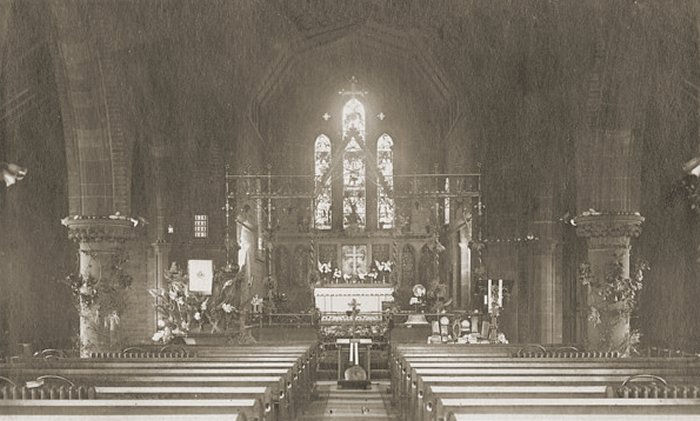
The interior of All Saints' Church. From an
old postcard.
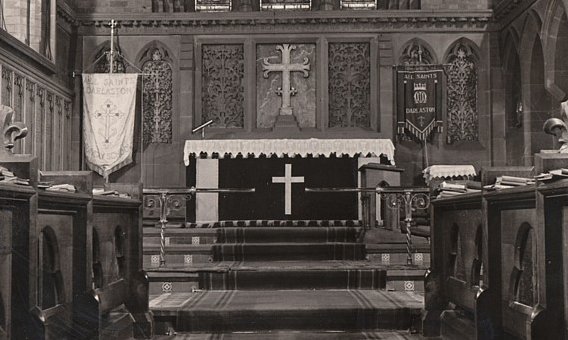
The alter after 1903.
| The church contained a magnificent wrought iron
chancel screen given by W. Martin Winn in memory of his
father, and a large brass lectern given by F.H. Lloyd &
Company. |
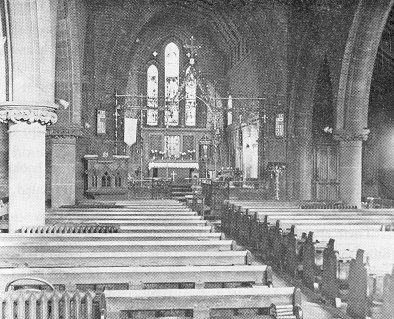
Another view of the interior of the church.
| In 1906 a piece of land adjacent to the church was
acquired by Mrs. Samuel Mills, Mr. S. M. Slater and Mr.
A. Slater on which to build a parish hall. The land was
offered to the church at half-a-crown a square yard and
became an extension to the All Saints Day School
playground. The original purpose for purchasing the land
was forgotten and so the parish hall was not built until
the early 1930s after the original purpose had been
rediscovered. The church and parish hall were
destroyed by a bomb on 31st July, 1942 during a bombing
raid on Guest Keen & Nettlefolds'
Atlas works. It made a crater 50ft. deep and 40ft. wide.
Luckily there were no casualties. This was the only
church in the diocese of Lichfield to be destroyed by
enemy action. |

The destruction left by the bomb.
| On 4th August, 1942 the church council formed a
restoration committee and made plans for the rebuilding
of the church. Services continued to be held in the All
Saints Day School building, which survived the blast and
suffered only minor damage. Over the next few years they
raised £10,000 towards the new church and also received
£28,320 from the War Damage Commission. |

The temporary church.
| The new church was designed by Lavender and
Twentyman of Wolverhampton and built on the site of the
old church by E. Fletcher of Kingswinford. It opened in
1952. |
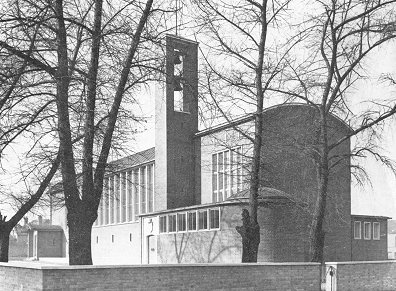
The new church.
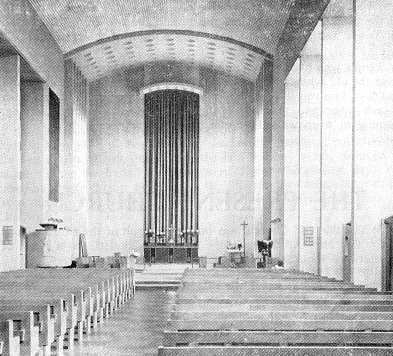
The interior of the new church.
| All Saints' Church, Moxley
As the population increased in the area, the new
ecclesiastical district of Moxley was formed in 1845 and
a church dedicated to All Saints, built on a piece
of land known as "Little Moxley Field".
Worship had
previously been conducted in the National School, built
in 1837.
The
church was designed by architect William Horton, and the tower,
built as a memorial to Thomas Wells, was added in 1877.
|
 |
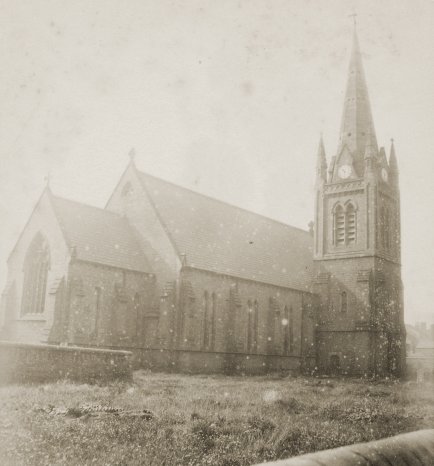 |
The first vicar, the Rev. Thomas Knight M.A.
resigned on 11th August, 1847 and was succeeded by the
Rev. Patrick Wilson M.A. A vicarage was built by the
church in 1849-50.
The foundation stone was laid on 3rd May, 1850 by
Lady Emily Foley, and the church was consecrated on
Friday 27th June, 1851.
Samuel Johnson Wells supplied the clock as a gift.
The choir stalls and clergy desks were given by Mr.
William Winn, Darlaston shopkeeper and councillor in
1884.
The photograph opposite, showing the back of the
church, and the rear graveyard, dates from about 1890. |
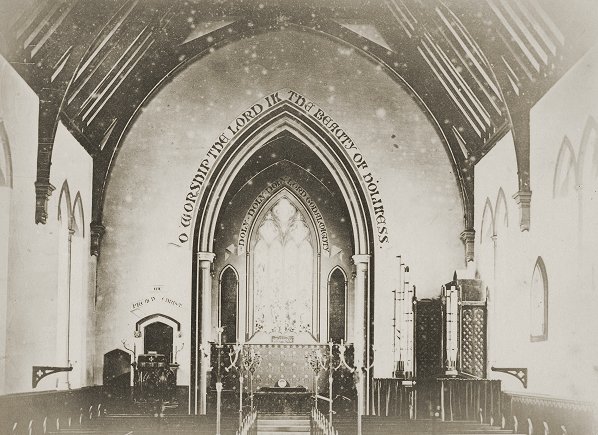
An interior view of the church from about
1890.
Wesleyan Chapel,
Pinfold Street
In the 1740s John Wesley and his supporters began
preaching in the Black Country, where they received a
very hostile reception. A group called the Darlaston Mob
played a leading part in persecuting the Methodists.
They were led by Richard Dorsett who was a churchwarden
at St. Lawrence's. The Dorsetts were an old Darlaston
family who became considerable land owners. John
Aldridge Dorsett, the last of the family to live here
and gave the council 18 acres of land either side of a
track, which later became Dorsett Road.
|

The Wesleyan meeting house in
Bilston Street. From the Methodist Recorder, June 1901. |
On Wednesday the 20th October 1743 John Wesley
preached at the High Bullen in Wednesbury, and was
attacked by the riotous Darlaston Mob. They took him to
appear before Colonel Lane at Bentley Hall, who was the
local justice of the peace. On the way they paused at
the White Lion in King Street for refreshment.
Wesley
feared for his life on this occasion, but later returned
to Darlaston many times, and eventually Wesleyanism
gained a sure foothold in the town.
In 1762 a house in
Bilston Street was licensed for worship by the
Wesleyans, and John Wesley preached here on a number of
occasions. The last occasion was in 1787 when he was 84
years old, just four years before he died.
|
| In 1810 the new Wesleyan Chapel opened in Pinfold
Street and the house became a private dwelling. The new
chapel cost £2,500 and initially attendance was good,
but by 1820 numbers had fallen drastically owing to the
trade depression after the Napoleonic wars.
Over the
next decade numbers slowly increased again until the
cholera epidemic of 1832 when attendance greatly
increased with 418 names on the class leader's books.
In 1833 the chapel was enlarged, the original plain
facade improved and the burial ground at the rear
opened.
The land for the graveyard was obtained from Mr.
Griffiths in exchange for land owned by Joseph Yardley
and Jabez Bills.
|
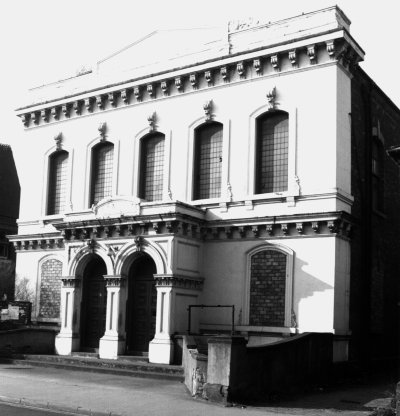
Pinfold Street Wesleyan Chapel
before demolition in1970. |
| The burial ground ran from the back of the chapel to
Blakemore's Lane, a distance of 104 yards, and land for
family vaults was given in exchange for a £10
subscription. The first burial took place in September
1833 and the first burial in a vault occurred on 13th
March, 1834. Although the cemetery has been derelict for
many years, some of the grave stones could still be seen
until recently behind Wesley Fold. |
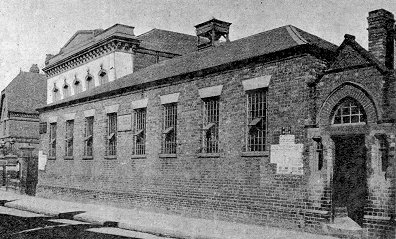
The Wesleyan School in Pinfold
Street. The Methodist Recorder, June 1901. |
The chapel contained a tablet dedicated to the
memory of John Wilkes who died in 1847. A new trust
was formed in 1851 consisting of William Longmore,
Samuel Longmore, William Maddock, Edward Cox, Edward
Glover, Samuel Partridge, J. Frost, Thomas Davies, John
Lees, Samuel Lees, Richard Dodd, Edward Caddick, Henry
Mills, Henry Walker, and Samuel Page. The congregation
included Simeon Carter and his wife Ann. Simeon and his
brother Reuben opened King's Hill Works, the first large
factory in the town. |
|
Adjoining Sunday and Day schools were erected in 1846
to the design of Mr. G. W. Green and built by Mr. Thomas
Adams at a cost of £439.19s.6d.
In 1888 the Wesleyan school had no less than 238
pupils and 160 infants. The average class size must have
been quite large as there were only two members of
staff, but some of the older pupils would have been
employed as assistants. At its height the school was the
third largest in Darlaston, the larger ones were:
|
1) |
The Old Church National School Smith Street
406 pupils, 133 infants |
|
2) |
The Central Board School
Slater Street
288 pupils, 140 infants |
In 1862 an organ was purchased and new classrooms
built at a cost of £850, and a minister's house built
next to the chapel in 1884 at a cost of £883. A second
enlargement of the chapel took place in 1876-7 and
memorial stones were laid to Mr. Enoch Horton, a
well-known liberal Methodist. The organ, built by Abbott
and Smith of Leeds cost £512.10s. The chapel was
renovated in 1907 and electric lighting replaced the old
gas lamps.
The building was demolished in 1970 and the
congregation moved to Slater Street and Great Croft
Street Methodist chapels.
United Methodist Church The building stood
in Great Croft Street and dated from 1852. It had
accommodation for about 500 worshippers. In 1909 the
Pastor was the Rev. S. Foster Waterhouse of the
Wednesbury and Darlaston circuit. There was a Sunday
School held at 9.30a.m. and 2p.m., and a Young People's
Institute held at 3.15p.m. Ladies' sewing meetings were
held on Mondays at 3p.m. A young men's class was held at
8.30p.m. on Thursdays and a prayer meeting took place on
Fridays at 7.30p.m.
|

The United Methodist
Church, as seen from Blakemore Lane.
Courtesy of Bill Beddow. |
|
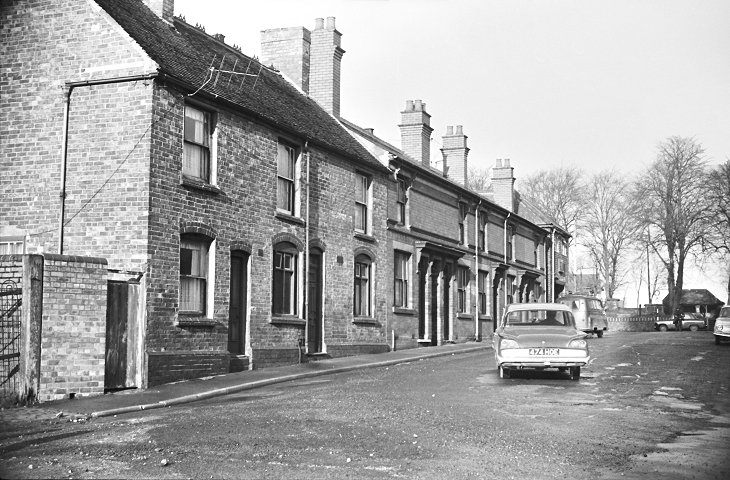
Looking up
Blakemores Lane towards the Owen
Memorial Garden. |
|
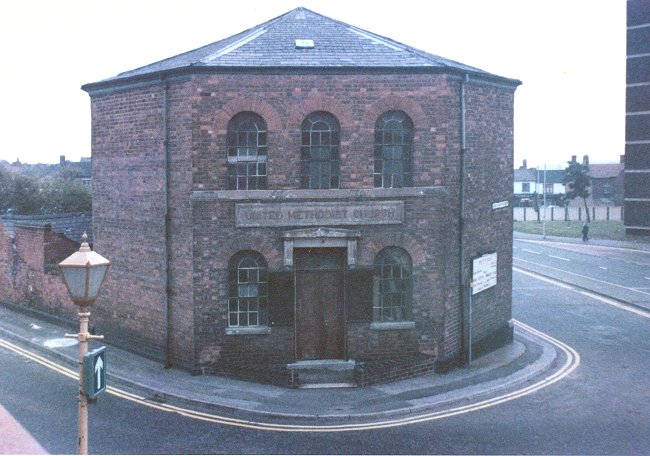
The United Methodist Church, after
the building of St Lawrence Way.
Courtesy of Brian Groves. |
|
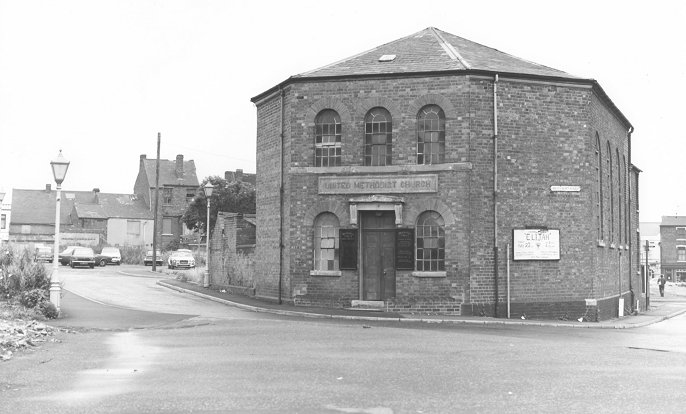
Another view of the church. |
|
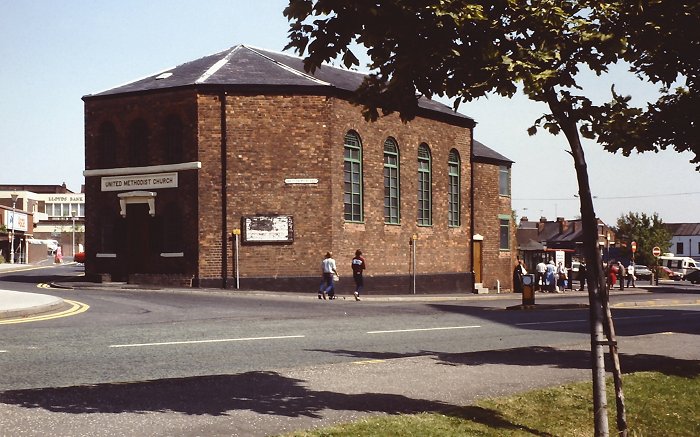
The church, as seen from across St
Lawrence Way. Taken by Richard Ashmore. Courtesy of John
and Christine Ashmore. |
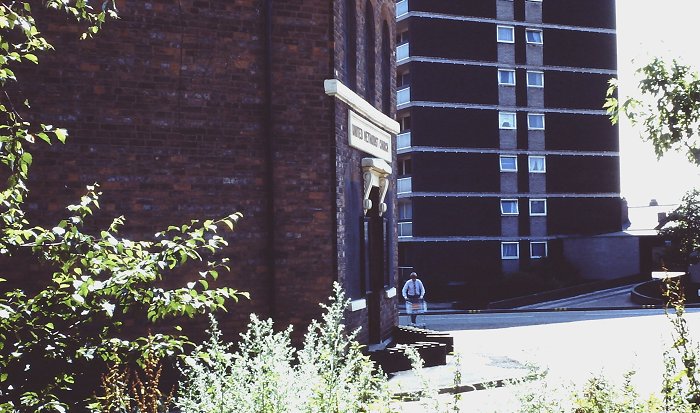
Looking towards St Lawrence Way
and the old flats. Taken by Richard Ashmore. Courtesy of John
and Christine Ashmore. |
|
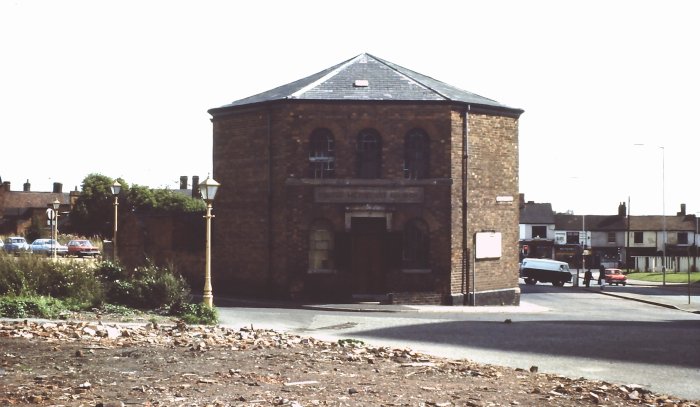
A view from the mid 1970s,
just before the building of the first ASDA
store. Taken by Richard Ashmore. Courtesy of John
and Christine Ashmore. |
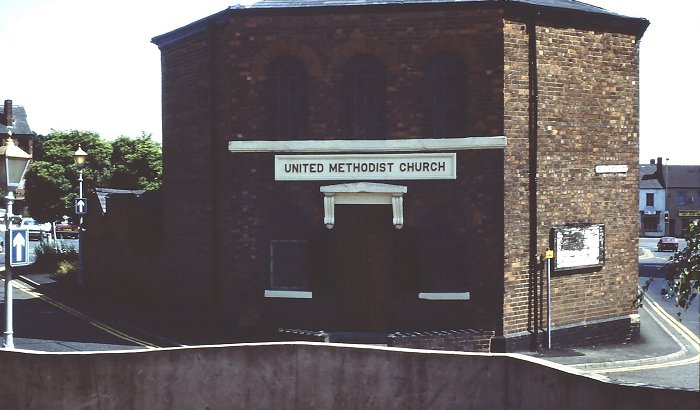
A final view of the
church, taken soon after the building of the
first ASDA store. Taken by Richard Ashmore. Courtesy of John
and Christine Ashmore. |
| The church was demolished after the building of the
first ASDA store in the late 1970s, when the town's bus
stops were moved closer to the store, and a small
traffic island was built on the site for the buses to
turn round. |
Bell Street ChapelIn 1819 Mr. Samson
Turner, a Primitive Methodist, came to Darlaston and
preached in the open air. There seems to have been a lot
of interest shown because he soon formed a society which
met in some of his rooms. The first people to join
included three businessmen, Mr. Carter, Mr. Ephraim Humpage, and
Mr. David Bowen. The society began to hold services in a
schoolroom in Blakemore's Lane and also in premises in
High Street. The first Primitive Methodist chapel was built in
Willenhall Street, between Stafford Road and Rough Hay
Road.
Land for the chapel and a schoolroom was acquired on
the 14th July, 1828 by William Butler of Wednesbury and
Job Stanaway of Darlaston, who was the trustee. The
other people involved included: Ephraim Humpage, a screw
maker; Joseph Perks, a stock taker; James Alston, a
brush maker; David Job Robinson, a miner; Obadiah Shou,
an iron maker; Samuel Bowen, a bridle maker; David
Bowen, a bit maker; William Hardy of Sedgley, a cow
keeper; and Thomas Cresswell of Bilston. |
|
This soon proved to be too small and so in 1836 a
larger chapel, seating 700 people, was built in Bell
Street at a cost of £2,600.
The movement grew in size
and the chapel was extended at a cost of £1209 including
electric lighting. All went well until the church
suffered structural damage in 1908 as the result of an
underground coal fire. The coal seam burned vigorously
and soon large cracks appeared in the building making it
unsafe. As a result demolition soon followed. |
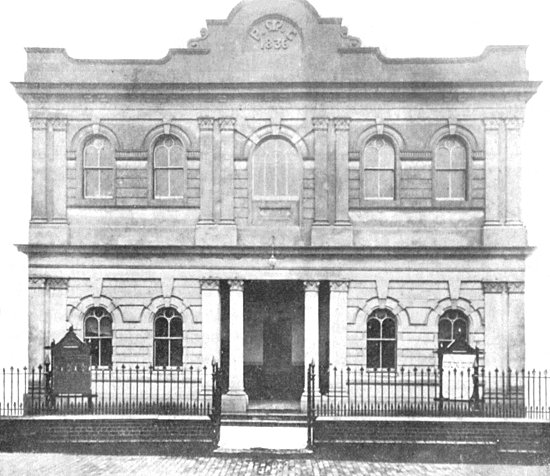
Bell Street Chapel. Courtesy of
Marjorie V. Stockham. |
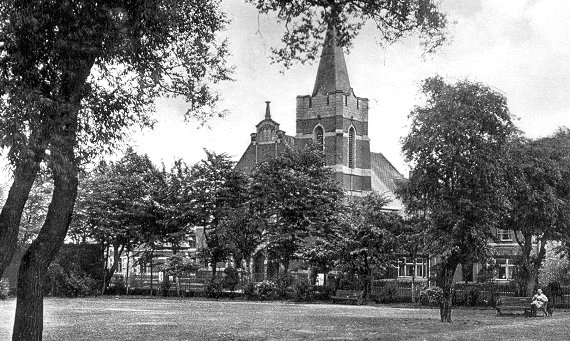 |
Slater Street Church
as seen from the park opposite.
From an old postcard. |
|
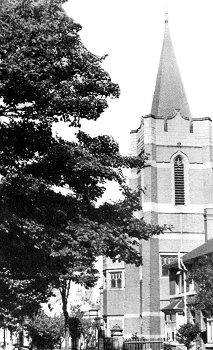
Slater Street Church. |
The church, a replacement for the Bell Street
Chapel, was built in Slater Street opposite the
football ground. It consisted of a nave, transepts,
a chancel, an organ chamber, and had a high square
tower. The pews, rostrum and fittings were made of
pitch pine and a central feature was the old Bell
Street Chapel pulpit.
The building was designed by Darlaston architect
Mr. C. W. D. Joynson and erected by local builder Mr.
R. Hammonds, also of Darlaston. The opening
ceremony took place at 3p.m. on Thursday14th April,
1910 with a service conducted by the Reverend Joseph
B. Bissell, the first resident minister. During the
ceremony the builder and architect presented keys to
Mrs Richard Bayley, Mrs David Etchells, and Mrs J. G.
Hartshorne.
The opening celebrations continued with a public
tea, held in the Town Hall between 5 and 6 o'clock
(tickets costing 9d) and a public meeting at 7
o'clock. |
|
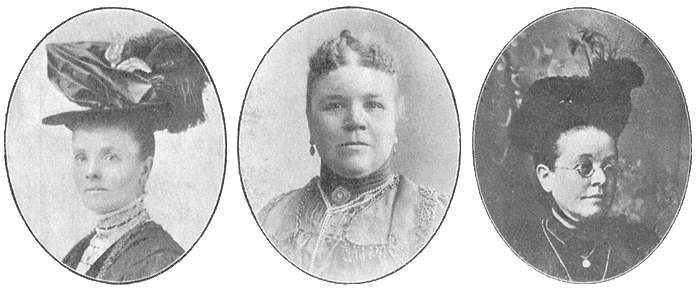
Mrs.
Richard Bayley, Mrs. David Etchells,
Mrs. J. G. Hartshorne. Courtesy of
Marjorie V. Stockham. |
|
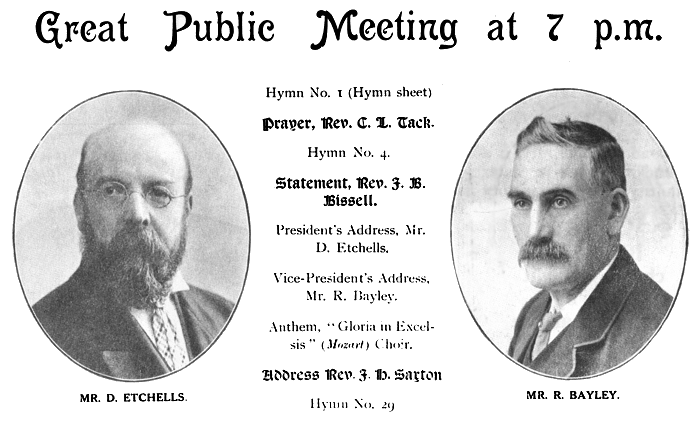
The
President and Vice-President.
Courtesy of Marjorie V.
Stockham. |
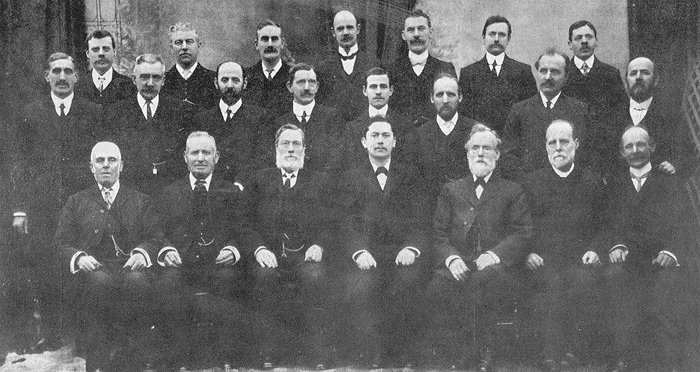
Church
trustees in 1910. Courtesy of
Marjorie V. Stockham.
Left to Right:
Back Row: S. Higgs, J. W.
Lowe, R. Bayley, T. Robinson, W.
Hunt, J. T. Harper, S. Hartshorne.
Middle Row: J. Small, H.
Davis, A. W. Cresswell, A. Roberts,
J. T. Jinks, J. Green, A. Cotterell,
I. E. Cresswell.
Front Row: M. Huskison, H.
Bird, E. Wilkes, Rev. J. B. Bissell,
T. Harper, R. Lees, H. Fernihough. |
| The first Sunday morning service took
place at 10.30a.m. on the 17th April and was
conducted by the Reverend Joseph Pearce of
Cradley Heath. In the afternoon the Bilston
Wesley Prize Choir gave a musical service.
The church survived for 69 years, and after
demolition in 1979 was replaced by today's
much smaller building. I would like to
thank Marjorie V. Stockham for the
information about Bell Street Chapel and
Slater Street Church. |
|

From an old postcard. |

A church youth club badge. |
|
Darlaston Green
Methodist Church
In the early 1830s a
Methodist society held meetings in a room at
Darlaston Green, known as “Shake’s Castle”.
Services were held on Sunday afternoons,
followed by a class meeting under the
supervision of a Mr. Banks. |
|
In 1842 an application
was made to the major local land-owner, the
Duke of Sutherland, at Groundslow, Trentham
for a piece of land on which to build a
church. The Duke replied in a letter dated
26th December, 1842 stating that
he would give a suitable piece of land to
the Methodist group.
The land was given on the
understanding that a stone would be erected
in front of the building, carrying the
following inscription: “The ground was given
by the Duke of Sutherland”. |
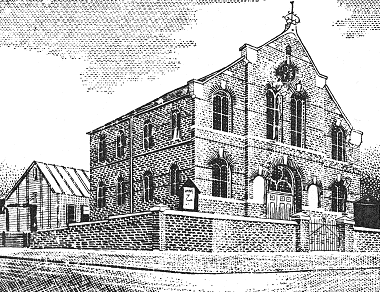
Darlaston Green
Methodist Church and school, Perry Street. |
|
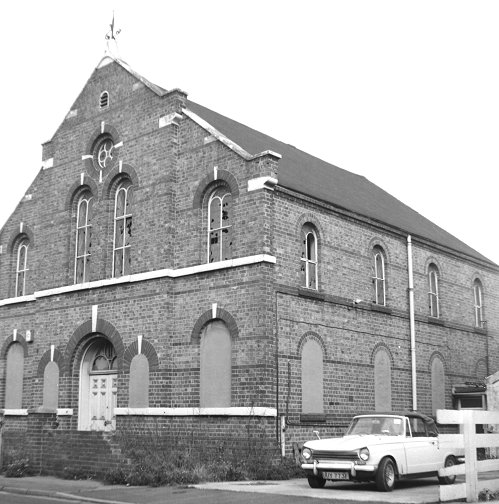
Darlaston Green
Methodist Church. Courtesy of Howard Madeley. |
The piece of land was
situated in Horton Street, adjacent to “The
Square” and the church opened its doors for
the first time in 1844.
The church had a
short life, as it only survived for 25 years
due to mining subsidence. On the eve of the
Sunday School anniversary in 1869 the
building was declared unsafe and the
celebrations were held outside in Horton
Street.
Undaunted, the Methodist
group raised funds for a new church and land
was acquired on the corner of Castle Street
and Perry Street on 3rd November,
1869, at a cost of £104.8s.0d. It appears
that Castle Street is named after the
original meeting room “Shake’s Castle”. |
|
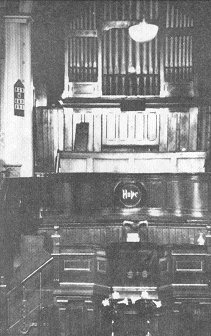
The Interior of
the church. |
The new church opened
in 1871 as “a place of meeting for
religious worship by a congregation or
assembly of persons calling themselves
Wesleyan Methodists”. The new church was
built at a cost of £1,132, the bricks
and £200 being given by Enoch Horton,
the remaining debt not being cleared
until 1916.
Within a few years of
opening, an American pipe organ was
installed, and a wooden schoolroom built
behind the church. In 1926 two gallery
wings were added.
By the late 1920s,
200 to 250 scholars met in the old
schoolroom on Sunday mornings and
afternoons, and the old building could
be very hot and unpleasant on summer
afternoons.
A school building fund was
started to raise money to replace the
old wooden school with a modern
brick-built building. The new school
opened in June 1949 and was a great
success. |
| By the time the
church’s centenary celebrations were
underway in 1970, most of the old Victorian
houses in the area had been demolished and
the church stood alone, surrounded by
derelict land.
Within not too many years the
church itself had gone, thanks to dwindling
attendance figures, which had been falling
since the end of World War 2. |
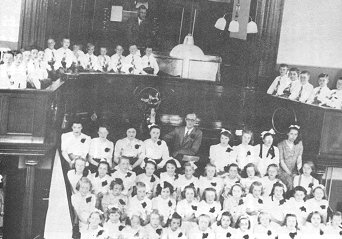
The Sunday School
Anniversary, 1947. |
|
The Salvation Army Citadel The
Salvation Army Corps at Darlaston were founded
in 1882 by two lady officers, Captain Nellie
Moore and Lieutenant Agnes Reynolds. Their old
building, which stood on the southern side of
High Street, was originally the Temperance Hall
and later called the Salvation Army Barracks. It
survived until the early 1970s when it was
demolished to make way for the original ASDA
store.
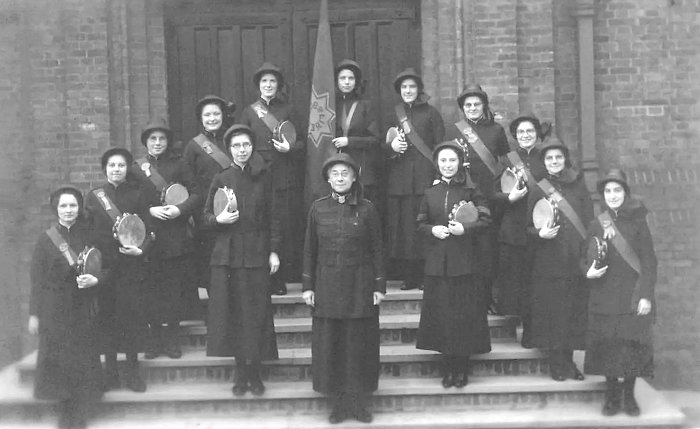
Members of the Salvation
Army in 1934. From an old postcard.
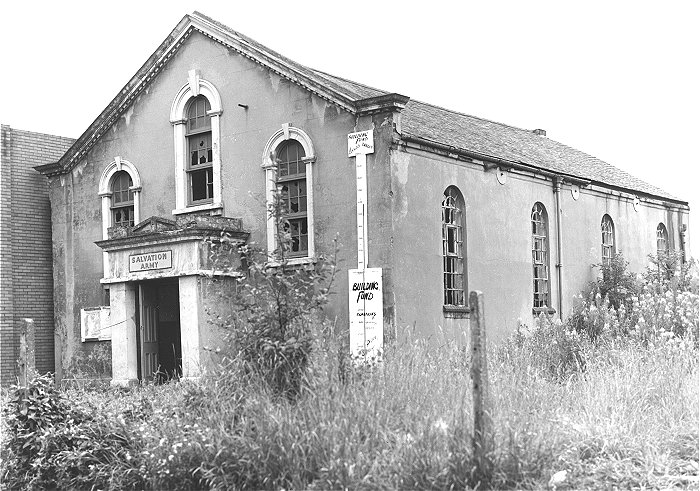
The Salvation Army
Citadel, just before demolition.

The Salvation Army Band in 1956. Courtesy of
Brian Groves.
Back row, left to right: Gordon
Cresswell, Charles Fletcher, Albert
Bayley, Thomas Small, Ernest Thomas.
Front row, left to right: Arthur
Small, George Kerry, Thomas Groves,
Derek Gibbs, Brian Groves, Ronald
Earp (bandmaster), Major Brenda
Hoskins (officer), Charles Hanwell,
Joseph Cresswell, John Groves,
Leslie Cresswell, Ernest Langley.
|
|
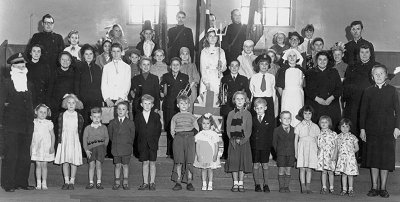 |
| Salvation
Army Sunday School Anniversary,
1956. Courtesy of Brian Groves.
|
| |
|
|
View some photographs of the
Salvation Army in Darlaston |
 |
| |
|
|
|
 |
 |
 |
Return to Nail
& Clock Making |
Return to
Contents |
Proceed to New
Roads and a Canal |
|